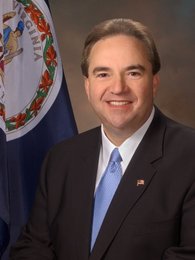Can Virginia Make it 10 in a Row as the Nation’s Naysayer?
For the last nine gubernatorial elections since 1977 Virginians have voted into office a governor from the opposing party of the sitting president

In 2009, GOP pick-ups of gubernatorial seats in New Jersey and Virginia were cast as a rejection of Democratic policies in D.C. (A view seemingly validated by – or at least correlated to – the Republican tsunami of 2010).
And now, with Republican Governor Chris Christie a virtual lock to win reelection in New Jersey, the main event this November will be the gubernatorial race in Virginia.
Republican State Attorney General Ken Cuccinelli and former DNC Chairman (and failed 2009 gubernatorial candidate) Terry McAuliffe are neck-in-neck in the polls, but suspicions that GOP Lieutenant Governor Bill Bolling might enter the race as an independent were bolstered today when the former Republican candidate sent out an email testing the waters for an “Independent Republican” run.
Pollsters have already been including Bolling’s name in three-way matchups with Cuccinelli and McAuliffe – neither of whom are particularly popular across the state – and he has received double-digit support in almost all of them.
Bolling, who ended his bid for the Republican nod three months ago, would likely cast himself as the moderate in the race.
However, his candidacy could very well put in jeopardy an electoral oddity that is nearly 40 years in the making in the Old Dominion State.
Over the last nine election cycles dating back to 1977, Virginia has elected a governor from the opposing political party of the sitting president who won the White House the previous November.
From the Elections of 1885 through 1965, Democrats – as they did in most southern states – won every gubernatorial race in Virginia.
The state voted governors into office of the same political party as the sitting president in 1961 (Democrat), 1965 (Democrat), 1969 (Republican), and 1973 (Republican).
But over the last nine elections…
· In 1977, one year after the election of Jimmy Carter, Republican John Nichols defeated Democrat and former Lieutenant Governor Henry Howell by 12.6 points.
· In 1981, after the election of Ronald Reagan, Democratic Lieutenant Governor Chuck Robb won the gubernatorial race with a 7.1-point victory over GOP Attorney General J. Marshall Coleman.
· In 1985, with Reagan winning a second term, Democrats held onto the governor’s seat with Attorney General Gerald Baliles beating Republican Wyatt Durrette by 10.4 points.
· In 1989, George H.W. Bush was inaugurated and Democrats won a third consecutive gubernatorial race with Lieutenant Governor Douglas Wilder narrowly beating 1981 GOP nominee J. Marshall Coleman by 0.4 points.
· In 1993, Clinton and the Democrats took back the White House and Republican congressman George Allen coasted to a 17.4-point victory over Democratic Attorney General Mary Sue Terry.
· In 1997, Clinton was reelected and Republicans held the governorship with Attorney General Jim Gilmore defeating Democratic Lieutenant Governor Don Beyer by 13.3 points.
· In 2001, George W. Bush took residence in the White House and Mark Warner won back the Executive Mansion for the Democrats by beating Republican Attorney General Mark Earley by 5.1 points.
· In 2005, Bush won a second term and Virginians elected Democratic Lieutenant Governor Tim Kaine by 5.7 points over Republican Attorney General Jerry Kilgore.
· In 2009, an Obama victory in the state the previous year could not help the party keep the governor’s seat with Republican Attorney General Bob McDonnell trouncing State Senator Creigh Deeds by 17.4 points.
And now, with Obama’s victory last November, Virginians have a chance to make it an even 10 in a row, should they elect Cuccinelli this fall.
That prospect, however, would seemingly be made much more difficult if Bolling runs, considering he could split the conservative/Republican vote in two, and only pry away a much smaller fraction of the Democratic vote from McAuliffe (banking on a large majority of independents to win).
Still, a recent poll by Quinnipiac (in the field February 14-18) shows McAuliffe up 34-31 on Cuccinelli with Bolling notching 13 percent and nearly one-quarter of the electorate undecided.
Recent strong performances by third-party or independent candidates in Virginia gubernatorial races include Lieutenant Governor Henry Howell’s 49.3 percent second place finish in 1973 as an independent (although in only a two-candidate field) and William Story’s 13.4 percent under the Virginia Conservative banner in 1965.
One final tidbit: New Jersey and Virginia have both voted for the same political party during the last six gubernatorial elections dating back to 1989.
Follow Smart Politics on Twitter.

1. George Allen was a FORMER US representative at the time of his election as governor, having declined to seek a full two-year term after being placed in the same district with another R incumbent (John Nichols DALTON began the “naysayer” streak, which ended with the defeat of Ciccinelli – though he, and a former R, standing as the Libertarian nominee, actually did garner a combined statewide majority vote).
2. If “Herr Drumpf” wins against “Hil” later this year, the Garden State will most likely continue the contrarian trend in its gubernatorial balloting, since it is unlikely that either he or the term-limited governor who is publicly backing the presumptive official(?) R nominee will be sufficiently popular by November of 2017.